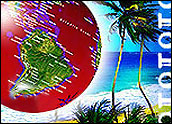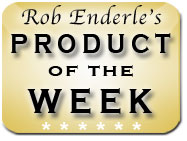
Last week marked the beginning of a big experiment for me: first living and then retiring outside of the U.S. I figure there are a lot of boomers like me who are exploring this idea as we become increasingly concerned about the costs of living in our chosen country and the inability of governments to balance budgets.
My wife and I looked at Costa Rica, Panama and Belize and settled on Sanctuary Belize as our final destination. Last week, we bought some land, where we’ll build our dream house. This will take a few years to get ready, and I’ll report back from time to time so you can see our progress.
I’ll close with my product of the week: a printer from Kodak that’s interesting not because of the printer itself but because of the business model, which could save you a ton of money on ink.
Technology Lets Us Live Anywhere
Even thinking about living outside the U.S. would be difficult if it weren’t for certain existing and emerging technologies. Phone calls are expensive, and learning another language is scary, and most of the countries that are both affordable and have great weather require that you learn Spanish.
However, with VoIP services like Vonage and Skype, you can dramatically reduce your phone bill, and you can also swap SIMS for either an international provider or one in country to dramatically reduce the cost.
In addition, with Microsoft’s purchase of Skype, it is expected that Windows phones will switch dynamically to Skype for long-distance calls within two years to reduce charges.
RosettaStone, the leading computer-based language program, now works on tablets and can help you get over the language hump.
Broadband is moving broadly in these countries, thanks to WiMax and LTE, which eliminates the need for using satellite services that provide horrid uplink data speeds and give out in storms. While not as fast as the fiber some of us have — or shortly will have — 4G performance is in line with DSL and most cable services for data.
Electrical power is often iffy and expensive in these countries, and hauling gas for generators isn’t a lot of fun. However, wind and solar generation have become vastly more available. Some of the newer windmills are like art, and they even have some now that are ultra-efficient.
Labor costs are low, as are some materials, and living costs can be a fraction of what you have seen in the U.S. There are a number of online services that offer seminars that can help you not only pick a location, but also make contact with the folks you’ll need to know to make your dream home a reality. We used Live and Invest Overseas ourselves.
Where We Looked
After reading the book Nextville, which started us on our adventure and helped us pick locations, we visited Costa Rica and Panama to see if we could live in either. Both are amazing — but we didn’t find a place that had a strong community.
While we came very close to buying a home in Panama, the prices seemed high for the location — and after studying the Napoleonic law that’s practiced there, we got very nervous. For instance, there was a blogger in Panama who had a bad experience with his bank and blogged about it. The bank froze his account (with US$5 million in it), and it took him 10 years to get it back. He decided to move back to Canada, and that story was enough for us to give that location a pass.
Another legal pitfall: If you buy something on time and miss a payment, the lender can take the asset and give you nothing in return — even if you’ve made all but the last payment on time — unless you have a specific clause in the contract to prevent it. In short, if you really understand the law, it is very straightforward; if you don’t (and I don’t), you’ll likely get screwed.
Of all of the countries we looked at, Panama was in the best shape financially. It was growing its ecosystem at an impressive rate, and had the best health program. In the end, though, the differences made it hard for us to see as anything more than an interesting place to visit.
Sanctuary Belize
We ended up choosing Sanctuary Belize in the southern part of that tiny nation, which used to be called “British Honduras.” A full writeup can be found here.

We spent the better part of a week at the site, which is unique in that there are ocean-front properties, jungle properties, savanna properties and equestrian properties all in one location. There will be homes with hangars and homes in the mountains.
Currently the development is investor-funded and carries no debt, which reduces substantially the risk of failure. It operates under a British legal system similar to that in the U.S., which provides protection for the buyer.
Part of what sold us on the site is the international airport being built about 20 miles away and the reasonable short hop plane service from the capital (30 minutes), which, while a bit of an adventure, does give you a chance to see a lot of this underpopulated country.
Also, it reminds me of where and when I grew up. You see, I grew up on an orange ranch in California, and at that time neighbors knew each other, folks on the street were friendly, and you could fly on planes much like you rode on buses. The only time you have to go through a major security scan is when you come back to the states.
Oh, and Belize doesn’t share your personal information with anyone — including the U.S. government. It’s not that I’m hiding anything, but with security breaches all over the U.S. — both inside and outside government — and Google indexing everything in site, I’m not feeling very safe at the moment.
What really closed the deal for us is that English is the national language, dollars are the main currency, Sanctuary Belize is largely a U.S. community, and the folks that run the business are wonderful. We kind of looked at each other and realized this eventually will be our new home.
This is a sanctuary. Most of it will never be built out (translation: unobstructed views). We’ve already lined up a wonderful builder out of Hawaii who won’t be learning building in the tropics on the job, and we will start looking at plans shortly. It’ll be an adventure.
Product of the Week: Kodak ESP Office 2170 Printer
 Kodak sent over a couple of printers for me to play with, and the one I like best for the money is the ESP Office 2170.
Kodak sent over a couple of printers for me to play with, and the one I like best for the money is the ESP Office 2170.
This is a great little printer — fast, quiet, with built-in sheet fed scanner, FAX and WiFi network connectivity. It has a multi-card flash reader in the front, a color display, and a USB port for other devices.

Kodak printers cost a little more, but they come with one big advantage. The ink costs a lot less — about half what most other printers charge per page, according to a Quality Logic report, which makes it the line best for folks who do a lot of printing.
Most printer companies have a razor/blade model: They sell the printers cheap and charge more for the ink, which is fine if you don’t print much. Kodak breaks that model, making a profit on the printer so it doesn’t need to charge as much for supplies.
Right now, it is only $119 on the Kodak site, which is really not bad.
Hey, like most folks, I like deals. The Kodak printer works fine — it is Kodak after all — and it saves money I can put toward my new house, so the Kodak printer line, and particularly the ESP Office 2170, is my product of the week.























































Your review is incomplete in a very significant way. It doesn’t state whether the printer uses ink cartridges which are ink only or ones that also include the ink jets (print head).
I have been advising clients on printer selection for many years (remember the Qume anyone?) and inkjets are a particular problem.
If not used frequently, the ink can dry and plug the print jets. Sometimes the ‘cleaning cycle’ will remedy this, but often the heads will not even respond to cleaning with solvent in a reasonable time. If the print head is integral to the printer this can result in the most cost effective solution to being a new printer.
If the print head is integral to the cartridge, the solution is simply to replace the cartridge.
Of course, the integrated cartridges are quite a bit more expensive per page. This means that if the client uses the color inkjet frequently, it is far more cost effective to use an ink only cartridge system.
I provide clients with a jpg file to print once per week to exercise the jets and to illustrate if any are inoperative. When they do this, it generally solves the problem. But often the person who has to do this ‘routine maintenance’ is an employee with no economic incentive to do it.
When the printer fails and won’t respond to a quick cleaning, I wind up with an irritated client and another printer is off to recycle or the dump. A very unsatisfactory result.
The Kodak printers you reviewed use the ink only cartridge design. This was not stated in your article, nor is it listed on their website or on-line store. I called their pre-sales support and get shuttled to a 3rd level CSR to get the answer.
When you were reviewing the printer, it would have been only few seconds to recall what the cartridge looked like when you installed it (them) and a few added words to provide this information to your readers. Sure hope you think to do so in the future.